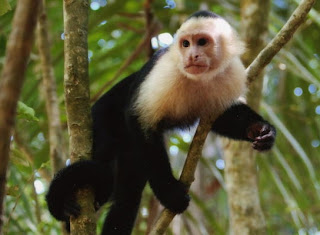The white faced capuchin also known as the white headed capuchin and the white throated capuchin, is a medium sized species of monkey that
is native to the jungles of Central America and the northern regions of
South America. The white faced capuchin is one of the most well known
monkeys, particularly in North America, and the white faced capuchin is
thought to be one of the most intelligent monkeys in the world
with the white faced capuchin being best known as a companion for organ
grinders and are also used to assist people that are paraplegic.
The white faced capuchin plays
a vital role in the eco-system where the white faced capuchin inhabits,
as the white faced capuchin is one of the most effective dispersers of
plant and fruit seeds throughout the jungle. The white faced capuchin
does this by eating the fruits and berries that grow in the surrounding
jungle and the seeds are then put back into the ground in the feces of
the white faced capuchin. The white faced capuchin live in troops which
generally contain around 20 individual white faced capuchin members.
The white faced capuchin is a highly adaptable mammal
and is known to live in all different types of forest in Central and
South America. Although the white faced capuchin mainly feeds on fruits
and berries, the white faced capuchin also eats insects, plants and even
small creatures such as frogs and birds. Within a white faced capuchin
troop, there tend to be more female white faced capuchin members than
males and as with many other species of sociable primates.
The
white faced capuchin troop generally has an alpha male member whose
primary role is to breed with the female members and to protect their
troop. White faced capuchin troops
are not thought to be highly territorial as they spend a great deal of
their time on the move. On average a white faced capuchin will travel 2
km every day but there always seems to be conflict when faced with a
different troop of white faced capuchin monkeys. Source









0 comments:
Post a Comment